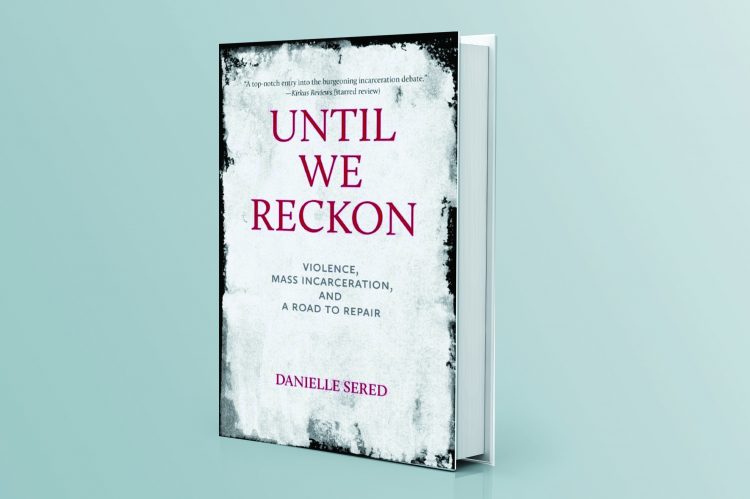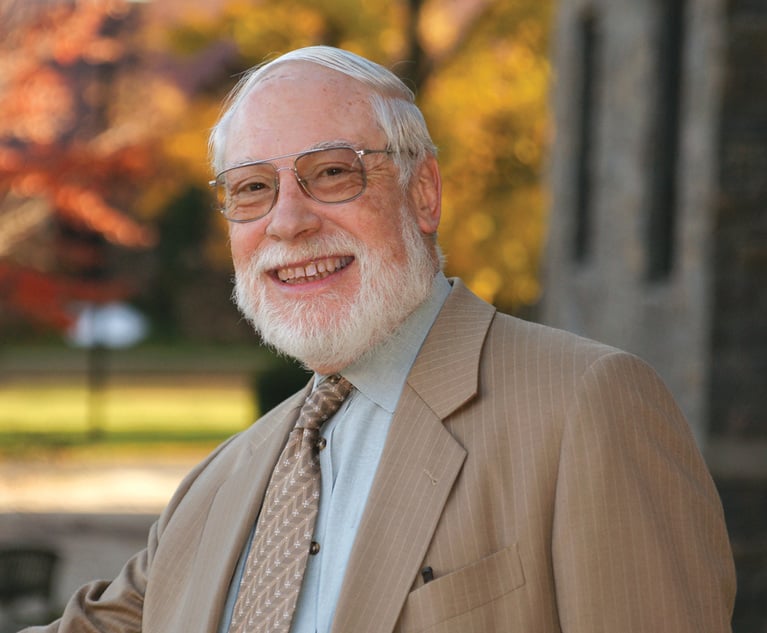'Until We Reckon' Is a Must-Read for Everyone Who Works in Criminal Courts
Danielle Sered's work with victims uniformly identifies the cry that those assaulted want to be heard. And yet studies show that half of this damaged population elect not to follow up with the police.
April 10, 2019 at 02:53 PM
6 minute read
 Danielle Sered's new book, “Until We Reckon,” is a must-read for anyone who works in the criminal courts, the many who care about making our streets and communities safer and all those who espouse concern for the simple concept of justice. The author writes as both a scholar (as in Rhodes) and doer, with her pioneering Common Justice program that creates an arena for bringing together the victims of violent crime with their assailants. She operates on the simple premise that the underpinnings believed to justify mandatory imprisonment for violent behavior are provably flawed. Broad-scale imprisonment has not made communities safer, nor given victims a lasting sense of security or, indeed, satisfaction.
Danielle Sered's new book, “Until We Reckon,” is a must-read for anyone who works in the criminal courts, the many who care about making our streets and communities safer and all those who espouse concern for the simple concept of justice. The author writes as both a scholar (as in Rhodes) and doer, with her pioneering Common Justice program that creates an arena for bringing together the victims of violent crime with their assailants. She operates on the simple premise that the underpinnings believed to justify mandatory imprisonment for violent behavior are provably flawed. Broad-scale imprisonment has not made communities safer, nor given victims a lasting sense of security or, indeed, satisfaction.
Engrossingly written, Sered points out that treating violence solely as an individual's pathology misses the mark, that that analysis importantly ignores the social context in which such crimes occur. Shame, lack of opportunity, poverty and simple inequity are most often the main drivers of this criminal violence. Indeed, broad policies that perpetuate substandard housing, inadequate education and devastation to entire families entirely innocent of wrongdoing are the fuel motoring our present “lock 'em up” system. With each incarceration, a caregiver to spouse and parents is lost, and an income provider as well. The lives of the assailant's children are invariably, and adversely, affected, with the periodic visit to daddy in prison-a tenuous connection at best.
And, of course, in society's eyes, the wrongdoer can never pay for his (and it is statistically male) criminal act. However long the imprisonment, there remain severe limitations on any kind of post-prison employment, no less a living wage. Frequent restrictions on housing, little to show by way of continued education, or self-awareness other than augmentation to the streetwise knowledge acquired by spending years together with other imprisoned felons, are not the fodder to productive citizenry. Indeed, prison life all too often proves to be a continuation of the violence known on the defendant's streets.
Strikingly, Sered provides data indicating that nearly everyone who commits violent crime has previously survived it, without ever having had access to the support required for a healthy recovery. That leads to her trenchant observation that it is purportedly for the survivors of assaults in whose name we practice this unyielding approach to incarceration.
Her work with victims uniformly identifies the cry that those assaulted want to be heard. And yet studies show that half of this damaged population elect not to follow up with the police. They want to understand why they were attacked. Most significantly they want assurance that what happened to them will not happen to anyone else. And, of course, they want a sense that now they will be personally secure.
What happens, in fact, offers these survivors little relief. Since most arrests result in plea bargains, the victims are not heard. Those few cases that go to trial place the victim in an unfamiliar and uncomfortable forum, limited by rules that constrict the full expression of her/his feelings and experience.
While incarceration provides short-term relief for some, it is a given that the victim knows that one day her/his assailant will most likely be back in the same community where the crime took place, and in which the victim lives. Given the lack of information provided to those harmed once a complaint is signed or testimony given in a grand jury, the victim will spend the next years fearing that there will be another confrontation with the assailant.
And, of course, the victim will never hear from the aggressor why he did what he did. Of at least equal significance, the assailant will never confront the human being whom he so violated, an interaction that is essential for him to pursue necessary behavioral adjustments.
Most every victim experiences profound, instant anger, and instinctively want to punish. But for what duration? Sered writes of Annie, who was brutally robbed and assaulted by a young man, of an age approximating that of her teenage son. “Ms. Annie, with all respect, may I [Sered] ask, when that man who assaulted you was sentenced to that long prison term, were you relieved? [And she answered] Oh yes, honey of course I was. [ And I asked:] Can I ask how long that relief lasted? And she said: Oh, baby, at least three or four hours.”
“And then I took the bus home, she said, and I was still afraid.” Annie describes her not sleeping, and the accompanying nightmares, and then, the “next morning I could not shake the image of that boy's mother face in court when those guards took her baby from her for good. Because that is my face.”
With the pathbreaking cooperation of the late Charles J. Hynes, then Brooklyn district attorney, Sered has continued her project with the assistance of Hynes' enlightened successors, the late Ken Thompson and incumbent Eric Gonzalez. With painstaking care, and on a completely voluntary basis, Sered and her group bring together the victims of violent crime with their assailants. Replacing the tough guy jargon of the D.A. did this, or the Judge did that, these men are confronted directly with the devastation their actions have caused to another, and to acknowledge this reality, directly, to the victim.
Step by step, these conversations evolve to the penalty phase, in which the victim plays a major role in formulating a sanction. It is often multi-faceted, including such diverse mandates as pursuit of a GED, the assailant educating the victim in martial arts, community service at a family's church, trauma-focused therapy, public speaking, keeping a daily journal reflecting on her victim's fear of re-entering a subway as a result of the underlying assault on a subway, with the assailant simultaneously barred from using the subway.
How much more constructive these evolvements are than the one-size fits all diktat embedded in the mandatory minimum sentence legislation, statutes which deprive judges, who possess at least a limited familiarity with a defendant, from applying more appropriate individualized sanctions.
The results are not surprising. The victim is heard, the assailant is forced to account for his serious criminal acts, and the devastating impact of imprisonment and a lifelong felony record is avoided. Significantly, but not surprisingly, the early data shows a dramatically reduced rate of recidivism and a dramatically increased rate of productive citizenry.
And this is just the first part. Sered writes that of the fraction of violent crimes reported to the police, only one-half result in arrests. Given what victims know about the criminal justice system, they would rather say nothing than submit themselves to it. Race, poverty, inadequate health and educational assistance profoundly contribute to the culture of violence so excessive in this country.
The victims do not report crime because of their lived experiences which inhibit the necessary trust required. Further, even if that trust were miraculously to appear, the codified mandate that we must imprison will simply lead to more violence. Sered makes a compelling case for the broader need to address the devastating impact, that we have left largely untouched, of institutionalized racial prejudice.
She writes of that bias woven through the long known, and now proven unfairness of stop and frisk practices, or the still extensive deprivation of equal access to equivalent housing, education and healthcare to entire communities substantially populated by men and women of color. It is essential, she concludes, that we recognize and address these institutionalized disparities.
Eric Seiff is of counsel to Storch Amini.
This content has been archived. It is available through our partners, LexisNexis® and Bloomberg Law.
To view this content, please continue to their sites.
Not a Lexis Subscriber?
Subscribe Now
Not a Bloomberg Law Subscriber?
Subscribe Now
NOT FOR REPRINT
© 2025 ALM Global, LLC, All Rights Reserved. Request academic re-use from www.copyright.com. All other uses, submit a request to [email protected]. For more information visit Asset & Logo Licensing.
You Might Like
View All
Law Journal Column on Marital Residence Sales in Pending Divorces Puts 'Misplaced' Reliance on Two Cases
8 minute read

A Time for Action: Attorneys Must Answer MLK's Call to Defend Bar Associations and Stand for DEI Initiatives in 2025
5 minute readTrending Stories
- 1Transgender Care Fight Targets More Adults as Georgia, Other States Weigh Laws
- 2Roundup Special Master's Report Recommends Lead Counsel Get $0 in Common Benefit Fees
- 3Georgia Justices Urged to Revive Malpractice Suit Against Retired Barnes & Thornburg Atty
- 4How Gibson Dunn Lawyers Helped Assemble the LA FireAid Benefit Concert in 'Extreme' Time Crunch
- 5Lawyer Wears Funny Ears When Criticizing: Still Sued for Defamation
Who Got The Work
J. Brugh Lower of Gibbons has entered an appearance for industrial equipment supplier Devco Corporation in a pending trademark infringement lawsuit. The suit, accusing the defendant of selling knock-off Graco products, was filed Dec. 18 in New Jersey District Court by Rivkin Radler on behalf of Graco Inc. and Graco Minnesota. The case, assigned to U.S. District Judge Zahid N. Quraishi, is 3:24-cv-11294, Graco Inc. et al v. Devco Corporation.
Who Got The Work
Rebecca Maller-Stein and Kent A. Yalowitz of Arnold & Porter Kaye Scholer have entered their appearances for Hanaco Venture Capital and its executives, Lior Prosor and David Frankel, in a pending securities lawsuit. The action, filed on Dec. 24 in New York Southern District Court by Zell, Aron & Co. on behalf of Goldeneye Advisors, accuses the defendants of negligently and fraudulently managing the plaintiff's $1 million investment. The case, assigned to U.S. District Judge Vernon S. Broderick, is 1:24-cv-09918, Goldeneye Advisors, LLC v. Hanaco Venture Capital, Ltd. et al.
Who Got The Work
Attorneys from A&O Shearman has stepped in as defense counsel for Toronto-Dominion Bank and other defendants in a pending securities class action. The suit, filed Dec. 11 in New York Southern District Court by Bleichmar Fonti & Auld, accuses the defendants of concealing the bank's 'pervasive' deficiencies in regards to its compliance with the Bank Secrecy Act and the quality of its anti-money laundering controls. The case, assigned to U.S. District Judge Arun Subramanian, is 1:24-cv-09445, Gonzalez v. The Toronto-Dominion Bank et al.
Who Got The Work
Crown Castle International, a Pennsylvania company providing shared communications infrastructure, has turned to Luke D. Wolf of Gordon Rees Scully Mansukhani to fend off a pending breach-of-contract lawsuit. The court action, filed Nov. 25 in Michigan Eastern District Court by Hooper Hathaway PC on behalf of The Town Residences LLC, accuses Crown Castle of failing to transfer approximately $30,000 in utility payments from T-Mobile in breach of a roof-top lease and assignment agreement. The case, assigned to U.S. District Judge Susan K. Declercq, is 2:24-cv-13131, The Town Residences LLC v. T-Mobile US, Inc. et al.
Who Got The Work
Wilfred P. Coronato and Daniel M. Schwartz of McCarter & English have stepped in as defense counsel to Electrolux Home Products Inc. in a pending product liability lawsuit. The court action, filed Nov. 26 in New York Eastern District Court by Poulos Lopiccolo PC and Nagel Rice LLP on behalf of David Stern, alleges that the defendant's refrigerators’ drawers and shelving repeatedly break and fall apart within months after purchase. The case, assigned to U.S. District Judge Joan M. Azrack, is 2:24-cv-08204, Stern v. Electrolux Home Products, Inc.
Featured Firms
Law Offices of Gary Martin Hays & Associates, P.C.
(470) 294-1674
Law Offices of Mark E. Salomone
(857) 444-6468
Smith & Hassler
(713) 739-1250







